


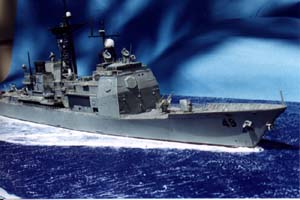 Building
the 1/350 Shanghai Dragon USS Vincennes with Gold Medal Models Modern
US Navy Fittings
Building
the 1/350 Shanghai Dragon USS Vincennes with Gold Medal Models Modern
US Navy Fittings
by Richard Eaton
Introduction
This kit was my first attempt at serious ship modeling several years ago. I purchased Gold Medal's excellent Modern USN set and went to town. I had never used PE on a ship model and wanted to gain experience. Recently, I decided to update the old model and make some water for it. I thought I would relate my experiences.
The Vincennes
In my book the Ticonderoga class Aegis guided missile cruiser (CG) is one of the sleekest and deadliest looking ships ever made. USS Vincennes (CG 49) was built by the Ingalls Shipbuilding Division of Litton Industries, Pascagoula, Mississippi. It was christened 14 April 1984, and commissioned on 6 July 1985.
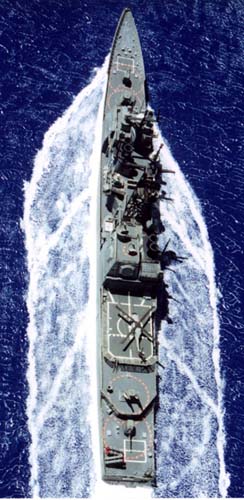 The
Vincennes was the first of the United States Navy's AEGIS Cruisers of
the Ticonderoga Class to enter the Pacific Fleet. Upon commissioning in
1985, Vincennes entered the Pacific Fleet via the Panama Canal and participated
in the testing and development of the SM-2 Block II surface-to-air missile.
In May 1986, Vincennes participated in the multinational exercise RIMPAC
86, coordinating the AAW efforts of two aircraft carriers and over forty
ships from five nations.
The
Vincennes was the first of the United States Navy's AEGIS Cruisers of
the Ticonderoga Class to enter the Pacific Fleet. Upon commissioning in
1985, Vincennes entered the Pacific Fleet via the Panama Canal and participated
in the testing and development of the SM-2 Block II surface-to-air missile.
In May 1986, Vincennes participated in the multinational exercise RIMPAC
86, coordinating the AAW efforts of two aircraft carriers and over forty
ships from five nations.
Vincennes deployed in August 1986 to the Western Pacific and Indian Oceans. During the 'first ever' Pacific Deployment of an Aegis cruiser, Vincennes served as Anti-Air Warfare Commander with both USS CARL VINSON (CVN 70) and USS NEW JERSEY (BB 62) Battle Groups. She also operated jointly with the Japanese Maritime Self-Defense Force and the Royal Australian Navy. Vincennes steamed over46,000 miles in waters from the Bering Sea to the Indian Ocean.
On 20 April 1988, during Fleet Exercise 88-1, Vincennes received unexpected orders to proceed back to San Diego and make preparations to leave on a six month deployment. One month later, the ship entered the Persian Gulf, to become part of the Joint Task Force in the Persian Gulf. During this tense time a civilian airliner was declared hostile by the ship's CIC, and when it failed to respond to radio messages and was unfortunately downed with all aboard being killed. During the course of this assignment it made fourteen transits of the Straits of Hormuz in support of Operation Earnest Will.
In February of 1990, Vincennes deployed on her third six month tour of the Western Pacific and Indian Oceans. In addition to covering the fleet with the 'Aegis Shield' and coordination all Battle Group air events, Vincennes served as the Command and Control Flagship during Harpoon-Ex-90. Vincennes spent more time at sea during deployment than any other ship in the Battle Group. In July 1990. Vincennes returned home after steaming nearly 100,000 miles. She deployed with SH-60S LAMPS MK III Anti-Submarine helicopters from HSL-45 Det 13. The embarked LAMPS detachment was a tremendous asset and performed superbly in its Anti-Submarine Warfare and Anti-Submarine Underwater Warfare roles.
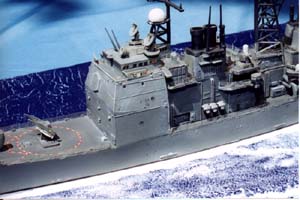 In
August 1991, Vincennes departed for her fourth Western Pacific Deployment.
Transiting with the USS INDEPENDENCE (CV 62), Vincennes performed duties
as the Anti-Air Warfare Commander for Battle Group Delta until detaching
to participate as the United States representative in MERCUBEX 91, a joint
United States and Singapore exercise. Vincennes returned from deployment
on the 21st of December 1991.
In
August 1991, Vincennes departed for her fourth Western Pacific Deployment.
Transiting with the USS INDEPENDENCE (CV 62), Vincennes performed duties
as the Anti-Air Warfare Commander for Battle Group Delta until detaching
to participate as the United States representative in MERCUBEX 91, a joint
United States and Singapore exercise. Vincennes returned from deployment
on the 21st of December 1991.
In June 1994, Vincennes departed on her fifth Western Pacific deployment. Transiting with the USS KITTY HAWK (CV 63) Battle Group, Vincennes performed duties as Anti-Air Warfare Commander for the Battle Group. During deployment, Vincennes conducted a number of exercises, including a larger scale joint exercise which Vincennes participated as the Area Air Defense Coordinator for the entire joint operating area. Vincennes returned from deployment on the 22nd of December 1994.
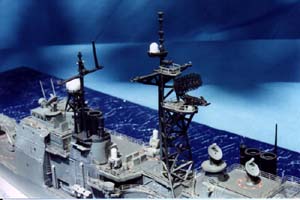 The
present Vincennes (CG 49) has established a reputation for excellence
over her nine years of distinguished service, and has remained on the
'cutting edge' of operational, tactical, and experimental naval developments
since commissioning. Vincennes has successfully fired more than 57 surface
to air missiles, 26 anti-submarine weapons, 5,000 five inch gun projectiles
and two harpoon anti-ship missiles.
The
present Vincennes (CG 49) has established a reputation for excellence
over her nine years of distinguished service, and has remained on the
'cutting edge' of operational, tactical, and experimental naval developments
since commissioning. Vincennes has successfully fired more than 57 surface
to air missiles, 26 anti-submarine weapons, 5,000 five inch gun projectiles
and two harpoon anti-ship missiles.
As the Battle Group Anti-Air Warfare Commander during her five Western Pacific Deployments, Vincennes was awarded the Navy Meritorious Unit Citation, the Battle "E" three times, the Combat Action Ribbon, the National Defense Medal, and the Sea Service Deployment Ribbon with four stars.
Building Vincennes
The old Shanghai Dragon kit is nicely detailed and includes fittings for an early Aegis Cruiser. It is a waterline model, and that is unusual for this scale. The Mark 26 and Harpoon rocket launchers are particularly well done. A beautifully molded SH-60B Seahawk helicopter is also included. Parts are crisp requiring only minor cleanup. The numerous antennae and weapon systems are detailed and appeared accurate. Kit decals were extensive and a real treat. They included everything from deck warning lanes, to helo markings, to the weapon systems E (for excellent) gunnery ratings.
Gold Medal Modern USN Fittings
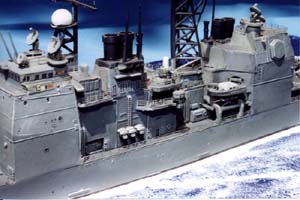 This
was my first experience with Gold Medal fittings. What can I say? I was
extremely impressed. I am still shocked at how well these products dress
up a model. The SPS-49 air search radar was a nice little kit in itself.
There is no comparison with the plastic parts provided. Railings, staircases,
and helo rotors really round out the appearance of the model. Gold Medal
includes excellent instructions with lots of hints and technique pointers.
Good thing too, because back then I needed all the help I could get!
This
was my first experience with Gold Medal fittings. What can I say? I was
extremely impressed. I am still shocked at how well these products dress
up a model. The SPS-49 air search radar was a nice little kit in itself.
There is no comparison with the plastic parts provided. Railings, staircases,
and helo rotors really round out the appearance of the model. Gold Medal
includes excellent instructions with lots of hints and technique pointers.
Good thing too, because back then I needed all the help I could get!
I prepared the parts as much as possible while still on the sprue. I did a bit of cleanup and then sprayed everything Testors gunship gray. This was too dark a gray for this ship but I recently lightened it by drybrushing with light gray. I sprayed the ship's decks dark gray and the masts and exhausts flat black. I topped the radar domes with flat white.
I assembled the ship without difficulty due to the great parts fit. I applied the numerous decals and wound up painting much of the deck and hanger markings in white. I assembled the weapons, detailed them, and put in place. The Standard SM-2 missiles are beautifully molded and painted white. The mark 45 five inch gun turrets are nicely molded. I detailed the gun barrels with paint to bring out details. I topped the Harpoon launchers in red paint.
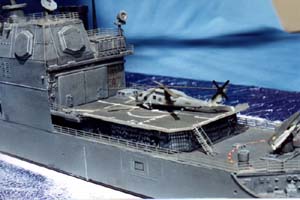 The
Seahawk helo was a mini kit in itself. I painted it light gray and black
and colored in the windows with pencil. I used The Gold Medal rotors in
place of the kit supplied one. Zap on the decals and the bird was ready
to fix to the deck.
The
Seahawk helo was a mini kit in itself. I painted it light gray and black
and colored in the windows with pencil. I used The Gold Medal rotors in
place of the kit supplied one. Zap on the decals and the bird was ready
to fix to the deck.
I then added the PE ladders and stairways. Then I installed the ships' railings working from the top superstructure down to the main deck. The large individually done safety webbing parts fixed around the flight deck are particularly nice. Gold Medal excels in their representation of radar arrays. The SPS-49 air search radar contained around five individual parts. Careful bending and assembling create a gorgeous part to top the model. I finished it in flat black. The Modern USN fret contains a selection of modern radars.
Weathering
I wanted a clean look for the model so I weathered lightly. I used a scale gray wash throughout assembly. I washed the hull and deck as well. I drybrushed the entire kit with light gray. (Several times over the years it turns out) Once I was happy with the look, I over sprayed with Dullcote.
Putting Vincennes at Sea
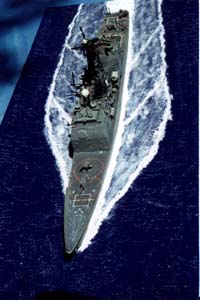 I
am reasonably happy with the way the kit turned out despite my many mistakes
in the original build. I thought this ship just had to have some water!
I cut out a large rectangle of foam board to form the base. I placed the
model on the board and drew an outline around the hull. I then painted
the entire surface with Ceramcoat acrylic royal blue and green. I used
Liquitex acrylic gloss heavy gel medium and a large brush to form a pattern
of waves across my "ocean." I built up bow waves with several applications
of the medium. Stipple the medium with a firm brush tip to rough up the
wake behind the ship.
I
am reasonably happy with the way the kit turned out despite my many mistakes
in the original build. I thought this ship just had to have some water!
I cut out a large rectangle of foam board to form the base. I placed the
model on the board and drew an outline around the hull. I then painted
the entire surface with Ceramcoat acrylic royal blue and green. I used
Liquitex acrylic gloss heavy gel medium and a large brush to form a pattern
of waves across my "ocean." I built up bow waves with several applications
of the medium. Stipple the medium with a firm brush tip to rough up the
wake behind the ship.
After drying overnight, the gel had a nice clear gloss finish to it. I thought about going over the surface with Future but it really was not necessary. I painted in the bow waves and wake with Ceramcoat white. Switch between thinned down blues and white to blend in things a tad. Once dry, I tacked the model in place with good old RC Z 56 and took it out in the sun for some photographs.
Conclusion
I recommend this kit and to most ship lovers. Average level ship builders would have a lot of fun building right out of the box. It builds up to a nice representation of this sleek, yet dangerous looking ship. Throw in the Gold Medal Models PE and I recommend this upgraded kit for experienced modelers.
Sources:
-
"Modern Naval Combat" David and Chris Miller (Salamander Books Ltd. 1986)
-
The Dictionary of American Naval Fighting Ships Online

Previous: Contents







